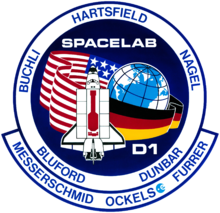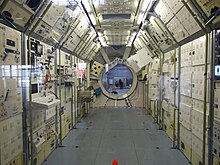Spacelab

Spacelab was a reusable laboratory used on certain spaceflights flown by the Space Shuttle. The laboratory comprised multiple components, including a pressurized module, an unpressurized carrier and other related hardware housed in the Shuttle's cargo bay. The components were arranged in various configurations to meet the needs of each spaceflight.
Spacelab components flew on a total of 32 Shuttle missions. Spacelab allowed scientists to perform experiments in microgravity in earth orbit.
Background

In August 1973, NASA and ESRO (now European Space Agency or ESA) signed a Memorandum of Understanding to build a science laboratory for use on Space Shuttle flights.[1] Construction of Spacelab was started in 1974 by the ERNO (subsidiary of VFW-Fokker GmbH, after merger with MBB named MBB/ERNO, and part of EADS SPACE Transportation since 2003). The first components produced, including lab module, LM1, were given to NASA free of charge by ESA in exchange for flight opportunities for European astronauts. A second module, LM2, was bought by NASA for its own use from ERNO.[citation needed]
Components
This section needs additional citations for verification. (March 2010) |
In addition to the laboratory module, the complete set also included five external pallets for experiments in vacuum, built by British Aerospace (BAe) and a pressurized igloo containing the subsystems needed for the pallet-only flight configuration operation. Eight flight configurations were qualified though more could be assembled.
Habitable module

The Spacelab Module comprises a cylindrical main laboratory configurable as Short or Long Module flown in the rear of the Space Shuttle cargo bay, connected to the crew compartment by a tunnel. The laboratory had an outer diameter of 4.12 meters (13.5 ft), and each segment a length of 2.7 meters (8.9 ft). Most of the time two segments were used in forming the Long Module configuration.
Two habitable modules were built, named LM1 and LM2. LM2 is now on display in the Bremenhalle exhibition in the Bremen Airport of Bremen, Germany. LM1 is now on display at the Udvar-Hazy center at the Smithsonian Air and Space Museum behind the Space Shuttle Discovery.
Pallet
The Spacelab Pallet is a U-shaped platform for mounting instrumentation, large instruments, experiments requiring exposure to space, and instruments requiring a large field of view, such as telescopes. The pallet has several hard points for mounting heavy equipment. The pallet can be used in single configuration or stacked end to end in double or triple configurations. Up to five pallets can be configured in the Space Shuttle cargo bay by using a double plus triple pallet.
A Spacelab Pallet was transferred to the Swiss Museum of Transport for permanent display on 5 March 2010. The Pallet, nicknamed Elvis, was used during the eight-day STS-46 mission, 31 July - 8 August 1992, when ESA astronaut Claude Nicollier was on board Shuttle Atlantis to deploy ESA's European Retrievable Carrier (Eureca) scientific mission and the joint NASA/Italian Space Agency Tethered Satellite System (TSS-1). The Pallet carried TSS-1 in the Shuttle's cargo bay.[2]
The Spacelab Pallet used to transport both Canadarm2 and Dextre to the International Space Station is currently to be found at the Canada Aviation and Space Museum, on loan from NASA through the Canadian Space Agency (CSA).[3]
Igloo
On spaceflight where a habitable module was not flown, but pallets were flown, a pressurized cylinder known as the igloo carried the subsystems needed to operate the Spacelab equipment.[4] The igloo was 10 feet tall, had a diameter of 5 feet, and weighed 2500 lbs.[5] Two igloo units were manufactured, both by Belgium company SABCA, and both were used on spaceflight.[5] An igloo component was flown on Spacelab 2, Astro-1, ATLAS-1, ATLAS-2, ATLAS-3, and Astro-2.[5]
Other components

Other Spacelab elements include the tunnel, and the Instrument Pointing System (IPS) tailored to the pallet interfaces for precise pointing to space or earth targets.
Spacelab missions



Spacelab components flew on 22 Space Shuttle missions from November 1983 to April 1998.[6] The Spacelab components were decommissioned in 1998, except the pallets. Science work was moved to the International Space Station and Spacehab module, a pressurized carrier similar to the Spacelab Module. A Spacelab Pallet was recommissioned in 2002 for flight on STS-99. The "Spacelab Pallet - Deployable 1 (SLP-D1) with Canadian Special Purpose Dexterous Manipulator, Dextre" was launched on STS-123. "Spacelab Pallet - Deployable 2 (SLP-D2)" was scheduled for STS-127.[citation needed] The Spacelab components were used on 32 Shuttle missions in total.
| Mission name | Orbiter | Launch date | Spacelab mission name |
Pressurized module |
Unpressurized modules |
|---|---|---|---|---|---|
| STS-2 | Columbia | November 12, 1981 | OSTA-1 | 1 Pallet[7] | |
| STS-3 | Columbia | March 22, 1982 | OSS-1 | 1 Pallet[8] | |
| STS-9 | Columbia | November 28, 1983 | Spacelab 1 | Module LM1 | 1 Pallet |
| STS-41-G | Challenger | October 5, 1984 | OSTA-3 | Pallet[9] | |
| STS-51-B | Challenger | April 29, 1985 | Spacelab 3 | Module LM1 | MPESS |
| STS-51-F | Challenger | July 29, 1985 | Spacelab 2 | Igloo | 3 Pallets + IPS |
| STS-61-A (D1) | Challenger | October 30, 1985 | Spacelab D1 | Module LM2 | MPESS |
| STS-35 | Columbia | December 2, 1990 | ASTRO-1 | Igloo | 2 Pallets + IPS |
| STS-40 | Columbia | June 5, 1991 | SLS-1 | Module LM1 | |
| STS-42 | Discovery | January 22, 1992 | IML-1 | Module LM2 | |
| STS-45 | Atlantis | March 24, 1992 | ATLAS-1 | Igloo | 2 Pallets |
| STS-50 | Columbia | June 25, 1992 | USML-1 | Module LM1 | EDO |
| STS-46 | Atlantis | July 31, 1992 | 1 Pallet[2] | ||
| STS-47 (J) | Endeavour | September 12, 1992 | Spacelab-J | Module LM2 | |
| STS-56 | Discovery | April 8, 1993 | ATLAS-2 | Igloo | 1 Pallet |
| STS-55 (D2) | Columbia | April 26, 1993 | Spacelab D2 | Module LM1 | Unique Support Structure (USS) |
| STS-58 | Columbia | October 18, 1993 | SLS-2 | Module LM2 | EDO |
| STS-59 | Endeavour | April 9, 1994 | SRL-1 | 1 Pallet | |
| STS-65 | Columbia | July 8, 1994 | IML-2 | Module LM1 | EDO |
| STS-64 | Discovery | September 9, 1994 | LITE | 1 Pallet[10] | |
| STS-68 | Endeavour | September 30, 1994 | SRL-2 | 1 Pallet | |
| STS-66 | Atlantis | November 3, 1994 | ATLAS-3 | Igloo | 1 Pallet |
| STS-67 | Endeavour | March 2, 1995 | ASTRO-2 | Igloo | 2 Pallets + EDO |
| STS-71 | Atlantis | June 27, 1995 | Spacelab-Mir | Module LM2 | |
| STS-73 | Columbia | October 20, 1995 | USML-2 | Module LM1 | EDO |
| STS-75 | Columbia | February 22, 1996 | Pallet[9] | ||
| STS-78 | Columbia | June 20, 1996 | LMS | Module LM2 | EDO |
| STS-82 | Discovery | February 21, 1997 | Pallet[9] | ||
| STS-83 | Columbia | April 4, 1997 | MSL-1 | Module LM1 | EDO |
| STS-94 | Columbia | July 1, 1997 | MSL-1R | Module LM1 | EDO |
| STS-90 | Columbia | April 17, 1998 | Neurolab | Module LM2 | EDO |
| STS-99 | Endeavour | February 11, 2000 | SRTM | Pallet |
Besides contributing to ESA missions, Germany and Japan each funded their own Space Shuttle and Spacelab missions. Although superficially similar to other flights, they were actually the first and only non-U.S. and non-European manned space missions with complete German and Japanese control.[citation needed]

The first West German mission Deutschland 1 (Spacelab-D1, DLR-1, NASA designation STS-61-A) took place in 1985. A second similar mission, Deutschland 2 (Spacelab-D2, DLR-2, NASA designation STS-55), was first planned for 1988, but due to the Space Shuttle Challenger disaster, was delayed until 1993. It became the first German manned space mission after German reunification.[11]
The only Japan mission, Spacelab-J (NASA designation STS-47), took place in 1992.
Other missions
- STS-92, October 2000, PMA-3, ( Discovery)
- STS-108, December 2001, Lightweight Mission Peculiar Support Structure Carrier (LMC) ( Endeavour)
- STS-123, March 2008, Pallet ( Endeavour), Dextre
Cancelled missions
Spacelab-4, Spacelab-5 and other planned Spacelab missions were cancelled due to the late development of the Shuttle and the Challenger disaster.
Legacy

The legacy of Spacelab lives on in the form of the MPLMs and the systems derived from it. These systems include the ATV and Cygnus spacecraft used to transfer payloads to the International Space Station, and the Columbus, Harmony and Tranquility modules of the International Space Station.[12][13]
References
- Notes
- ^ Lord 1987, pp. 24-28.
- ^ a b "ESA hands over a piece of space history".
- ^ "Spacelab pallet completes its long journey arriving at the Canada Aviation and Space Museum".
- ^ Joseph A. Angelo (2007). Human Spaceflight. Facts on File. p. 272. ISBN 0-8160-5775-3.
- ^ a b c "Spacelab Subsystems Igloo". National Air and Space Museum. Retrieved 23 November 2010.
- ^ David Michael Harland (2004). The Story of the Space Shuttle. Springer Praxis. p. 444. ISBN 978-1-85233-793-3.
- ^ "STS-2". NASA. Retrieved 23 November 2010.
- ^ "STS-3". NASA. Retrieved 23 November 2010.
- ^ a b c "Spacelab joined diverse scientists and disciplines on 28 Shuttle missions". NASA. 15 March 1999. Retrieved 23 November 2010.
- ^ Tim Furniss; David Shayler; Michael Derek Shayler (2007). Manned Spaceflight Log 1961-2006. Springer Praxis. p. 829.
- ^ "Germany and Piloted Space Missions". Fas.org. Retrieved 2012-04-17.
- ^ "A new European science laboratory in Earth orbit" (PDF).
- ^ "Cygnus Beyond Low-Earth Orbit – Logistics and Habitation in Cis-Lunar Space" (PDF).
- Sources
- Lord, Douglas R. Spacelab An international success story, NASA-SP-487. NASA, January 1, 1987.
- SLP/2104-2: Spacelab Payload Accommodation Handbook




